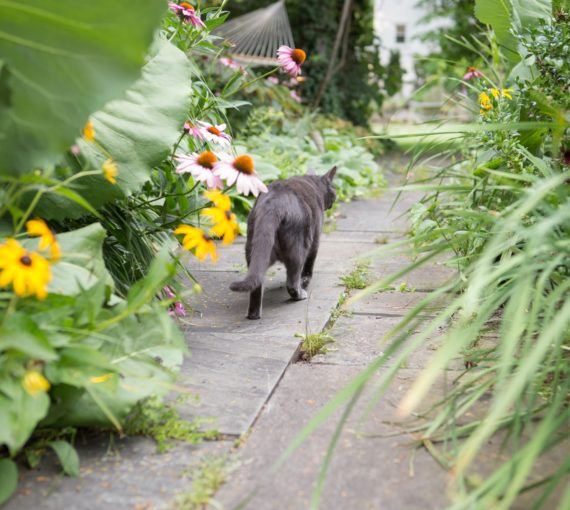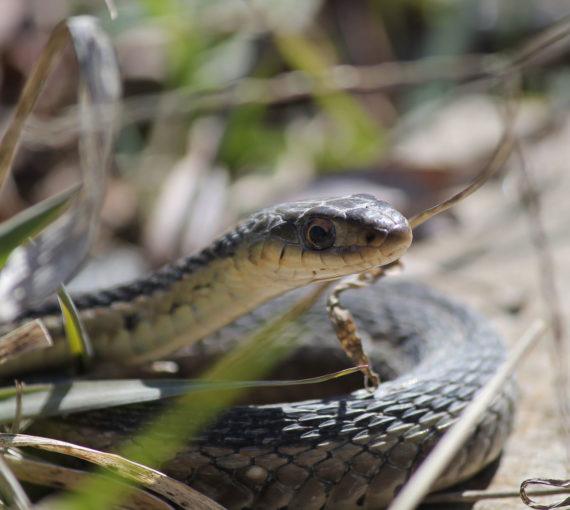
Raccoons have adapted well to urban life where food and shelter are plentiful. (Photo: Patrice Schoefolt via Pexels)
Our sprawling species now occupies almost every place on the planet. We’ve pushed out a lot of wildlife. But some animals — such as raccoons, skunks, coyotes, rodents and birds — have adapted to city life and are present around urban parks, neighbourhoods and yards.
Living harmoniously alongside urban wildlife requires respect, education and proactive measures. By understanding why animals are in cities, respecting their presence and taking steps to deter them humanely (when needed), we can create an environment where humans and wildlife can thrive.
Humans are part of nature, and we depend on nature’s balance for our survival. Embracing coexistence with wildlife is not optional. It’s our responsibility.
Why are wild animals in urban spaces?
Our current era, the Anthropocene, describes the extent to which our collective human footprint is changing the planet. It’s characterized by human-dominated landscapes, chaotic climate and reduced wildlife populations. Urbanization leads to habitat loss, forcing some creatures to seek new environments for food, shelter and safety.
Some species of urban wildlife, like coyotes and raccoons, have adapted and now thrive in human-dominated landscapes.
Urban spaces offer a variety of benefits for adaptable species:
- Food. Garbage bins, compost, gardens and even pet food provide easy meals for animals like raccoons, skunks and rodents.
- Shelter. Abandoned buildings, sheds, attics, green spaces and dense neighbourhood shrubbery can serve as homes for wildlife species.
- Safety. Some animals find refuge in urban environments where natural predators are less prevalent.

Common wildlife found in North American cities:
- Bears
- Birds
- Coyotes
- Cougars
- Deer
- Foxes
- Skunks
- Rodents
- Raccoons
- Rabbits and hares
The mutual benefits of coexistence
Coexistence means fostering a long-term and dynamic state in which humans and wildlife co-adapt to sharing landscapes. This approach to wildlife management is aligned with Indigenous world views of coexistence and Indigenous-led conservation practices.
Typically, the Western approach to managing urban wildlife has involved using lethal means (i.e., culling) to reduce risks to humans from animals.
Studies show that coexistence strategies and programs that prioritize non-lethal techniques (like the tips below) and changes in human behaviour are more effective at preventing conflicts with urban wildlife in the long term. “When humans coexist with and avoid persecuting wildlife in and around our communities, we safeguard ecosystem health, agricultural stability and food security.” Healthy urban wildlife populations support balanced ecosystems, pollination, flood mitigation and erosion control.

Case study on coyotes in North America
A 2024 International Fund for Animal Welfare study included a case on coyotes in North America. It found that though coyotes have been villainized due to their presence in cities and towns, they play an important role in urban ecosystems. Coyotes are often the largest predator and have top-down influences, helping regulate populations of other urban wildlife such as geese, deer and rodents.
How to respect and protect urban wildlife
Living alongside urban wildlife requires respect, education and proactive measures. By understanding why these animals are in our cities and respecting their presence and right to occupy these spaces, we can take steps to deter them humanely and create a harmonious environment where humans and wildlife thrive.
- Keep your distance. They may be cute, but it’s important to respect their space. This will keep you and them safe.
- Don’t feed. Feeding wildlife can lead to dependency on human-provided food, disrupt natural foraging behaviour and potentially cause serious health issues. If you want to help wild animals, the best thing you can do is provide natural food sources such as bird feeders and native plants.
- Respect habitats. Urban areas can be challenging for wildlife, especially when their natural habitats are affected. Help urban wildlife thrive by protecting green spaces, conserving water and not using toxic pesticides or other chemicals on your garden and lawn.
- Don’t trap and/or move them. Animals living in the city don’t know how to survive when relocated from home. If you’re worried a wild animal is injured or in distress, call your provincial SPCA helpline or the closest wildlife rehabilitation facility for help.
- Educate yourself and others. Understanding the behaviours and needs of local wildlife can foster empathy and responsible community actions. Help de-stigmatize urban wildlife by sharing what you learn with your neighbours, family and friends. You can also talk to your mayor or city councillor about the impact urban sprawl development has on wildlife habitats.
Report animal sightings to your local municipality wildlife management services.

How to prevent wildlife injuries and help when they happen
Do you know what to do if you come across a sick, injured or orphaned wild animal? Following a few simple guidelines, you can help keep the “wild” in wildlife.
How to deter wildlife from your home
Coexistence is ideal. But there are times when wildlife may pose a threat to property and human safety.
If you’re experiencing persistent, disruptive wildlife visits, try these humane, non-lethal, eco-friendly deterrent strategies:
- Seal entry points. Block potential entrances to your home (e.g., roof vents, plumbing mats, pet doors, bathroom vents and chimneys).
- Secure trash and food sources. Keep garbage and compost bins securely covered. If you live in an urban area prone to animal interactions, invest in wildlife-proof garbage bins. Never leave pet food outside overnight. Take out bins the morning of collection instead of the night before.
- Use eco-friendly, safe repellents. Repellents like vinegar can deter animals in certain areas. Motion-activated lights or sprinklers can also be effective.
- Remove attractants. Tidy up messes, spills and outdoor waste. Make sure barbecue areas are cleaned thoroughly. Use non-spill bird feeders.
- Install fencing. Proper fencing can keep larger animals, such as deer, out of gardens and yards.
How to deter urban wildlife from your garden
Is your garden persistently damaged or eaten by wildlife?
Create a physical barrier
Often called an “exclusion strategy,” erecting a physical barrier (e.g., fencing, nets, etc.) around your garden is a long-term, preventative method to keep wildlife from your garden.
If wildlife find your garden attractive in certain seasons, install a temporary barrier you can easily put up and take down as needed (e.g., wire cloches).
Ensure your physical barrier is suited to wildlife that frequents your garden most:
- Deer. Fencing should be at least six feet tall and opaque.
- Rodents. Chicken wire fencing will help deter small critters.
- Diggers. Bury your fencing at least 15 centimetres deep to keep rabbits, squirrels and other diggers from tunneling underneath.
- Birds. Use netting or wire cloches around fruit trees, berry bushes and other plants that birds like to eat.
Try animal-repelling plants
Fragrant flowers and herbs are great for beautifying your garden and driving away unwanted wildlife. Bonus: They may also repel other “pests” like mosquitos, aphids and mites!
Tip! If you have frequent wildlife visitors eating from your garden, consider limiting or omitting fruit-bearing plants and nut-producing trees. They’re highly attractive to bears, raccoons and coyotes.
Examples of wildlife-repelling flowers and plants:
- Daffodils. Daffodil bulbs contain a toxin that deters common critters such as insects, voles, squirrels and mice.
- Garlic and/or onions. The pungent smell of garlic and/or onion are great for keeping moles or rabbits from digging up your yard.
- Lavender. Effective in repelling mice, mosquitos and other common “pests.”
- Purple coneflower (a.k.a. Echinacea). This edible plant native to Ontario is great for treating common cold symptoms, attracting pollinators and deterring mice and rats.
- Rosemary. The flavorful and fragrant herb repels deer, mice and rats.
- Russian sage. Great for repelling deer and rabbits. Best planted around the perimeter of a garden.
Tip! Plant wildlife-repelling flowers and plants strategically (e.g., place deterrents around the most vulnerable plants).

How to keep cats out of the garden
Are neighbourhood kitties digging in your garden? Try these solutions to keep cats out of garden beds and away from the food you grow!
How to manage wildlife encounters
Though most interactions with urban wildlife are harmless (they’re generally more afraid of us!), depending on where you live, you may encounter larger animals like bears, cougars, foxes and coyotes.
What to do if a large wild animal approaches you:
- Stop. Do not move toward it. Pick up children and small pets.
- Stay calm and stand still. Avoid sudden movements. Never run.
- Make yourself big. Wave your hands above your head.
- Be loud. Shout, stomp your feet and clap your hands.

Worried about your pets?
Urban wildlife can pose various risks to pets (and vice versa!), from physical confrontations to disease transmission. Whether you’re at the park, on a trail or in your backyard, protect your pets and urban wildlife:
- Keep pets leashed in areas where you may encounter wildlife. Always follow local leash regulations.
- Ensure your pet has emergency recall training. If your pet is often off-leash in permitted green spaces or your backyard, emergency recall training can prevent scary, possibly life-threatening wildlife encounters.
- Don’t let your pet chase wildlife or roam unsupervised. Be especially cautious at dawn and dusk, the most active times for wildlife.
- Watch out for young wildlife. Many animals and birds build nests and raise their young in the spring and summer. If your pet brings you a young animal, keep your pet inside and away from the area to prevent injury to other young.
- Keep your cat inside, especially at night. Cats are most likely to hunt at night. This will also keep them safe from nocturnal predators.



